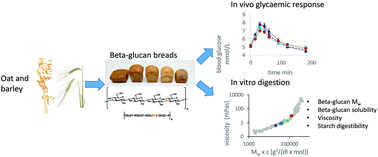当前位置:
X-MOL 学术
›
Food Funct.
›
论文详情
Our official English website, www.x-mol.net, welcomes your
feedback! (Note: you will need to create a separate account there.)
At a high dose even partially degraded beta-glucan with decreased solubility significantly reduced the glycaemic response to bread†
Food & Function ( IF 5.1 ) Pub Date : 2019-02-15 00:00:00 , DOI: 10.1039/c8fo02098a Anne Rieder 1, 2, 3, 4 , Svein H. Knutsen 1, 2, 3, 4 , Aida Sainz Fernandez 5, 6, 7 , Simon Ballance 1, 2, 3, 4
Food & Function ( IF 5.1 ) Pub Date : 2019-02-15 00:00:00 , DOI: 10.1039/c8fo02098a Anne Rieder 1, 2, 3, 4 , Svein H. Knutsen 1, 2, 3, 4 , Aida Sainz Fernandez 5, 6, 7 , Simon Ballance 1, 2, 3, 4
Affiliation

|
Cereal beta-glucan can reduce post-prandial glycaemic responses, which makes it an interesting ingredient to improve the health impact of bread, a staple food with a high glycaemic index (GI). Here we compare the ability of different wheat-based breads prepared with oat bran concentrate and barley flour and a Norwegian type of soft wrap (lompe) for their ability to reduce glycaemic responses in healthy adults. Both breads with the highest beta-glucan content (3.8 g per serving) significantly reduced peak blood glucose rise (PBGR), incremental area under the blood glucose curve (iAUC) and GI compared to wheat control regardless of beta-glucan Mw and solubility. At a medium dose of 1.7 g per serving breads with beta-glucan of high MW and solubility significantly lowered iAUC, but not GI or PBGR compared to white bread. In contrast to previous studies, no significant correlation between viscosity after in vitro digestion and any of the glycaemia variables was found. However, the amount of soluble beta-glucan per serving was inversely correlated with GI. Lompe had a similar medium GI (63) than the high dose beta-glucan breads (56 and 64). However, while “lompe” had significantly lower amounts of rapidly digestible starch, no differences in in vitro starch digestion were found between the different breads. Instead, increased local viscosity at the intestinal border (e.g. soluble beta-glucan interacting with the mucus layer), dilution of nutrients (higher water content and serving size) and/or reduced gastric emptying are proposed as potential explanations for the lower glycaemic responses to high dose beta-glucan breads.
中文翻译:

高剂量时,即使部分降解的β-葡聚糖具有降低的溶解度,也显着降低了对面包的血糖反应†
谷物β-葡聚糖可降低餐后血糖反应,这使其成为改善面包对健康的影响的有趣成分,而面包是具有高血糖指数(GI)的主食。在这里,我们比较了用燕麦麸皮浓缩物和大麦粉以及挪威包装的软包装(lompe)制备的不同小麦基面包在健康成年人中降低血糖反应能力的能力。与小麦对照组相比,两种β-葡聚糖含量最高的面包(每份3.8 g)均显着降低了峰值血糖升高(PBGR),血糖曲线下的增加面积(iAUC)和GI,而与β-葡聚糖M w无关和溶解度。与白面包相比,在中等剂量的每份面包1.7 g中,具有高MW和溶解度的β-葡聚糖可显着降低iAUC,但不会降低GI或PBGR。与以前的研究相反,在体外消化后的粘度和任何血糖变量之间均未发现显着相关性。然而,每份中可溶性β-葡聚糖的量与GI呈负相关。与高剂量的β-葡聚糖面包(56和64)相比,Lompe具有类似的中等GI(63)。然而,尽管“ lompe”的快速消化淀粉含量明显较低,但不同面包之间的体外淀粉消化没有差异。取而代之的是增加肠道边界处的局部粘度(例如 可溶性β-葡聚糖与粘液层相互作用),营养物质的稀释(较高的水含量和份量)和/或减少的胃排空被提出作为对高剂量β-葡聚糖面包较低血糖反应的潜在解释。
更新日期:2019-02-15
中文翻译:

高剂量时,即使部分降解的β-葡聚糖具有降低的溶解度,也显着降低了对面包的血糖反应†
谷物β-葡聚糖可降低餐后血糖反应,这使其成为改善面包对健康的影响的有趣成分,而面包是具有高血糖指数(GI)的主食。在这里,我们比较了用燕麦麸皮浓缩物和大麦粉以及挪威包装的软包装(lompe)制备的不同小麦基面包在健康成年人中降低血糖反应能力的能力。与小麦对照组相比,两种β-葡聚糖含量最高的面包(每份3.8 g)均显着降低了峰值血糖升高(PBGR),血糖曲线下的增加面积(iAUC)和GI,而与β-葡聚糖M w无关和溶解度。与白面包相比,在中等剂量的每份面包1.7 g中,具有高MW和溶解度的β-葡聚糖可显着降低iAUC,但不会降低GI或PBGR。与以前的研究相反,在体外消化后的粘度和任何血糖变量之间均未发现显着相关性。然而,每份中可溶性β-葡聚糖的量与GI呈负相关。与高剂量的β-葡聚糖面包(56和64)相比,Lompe具有类似的中等GI(63)。然而,尽管“ lompe”的快速消化淀粉含量明显较低,但不同面包之间的体外淀粉消化没有差异。取而代之的是增加肠道边界处的局部粘度(例如 可溶性β-葡聚糖与粘液层相互作用),营养物质的稀释(较高的水含量和份量)和/或减少的胃排空被提出作为对高剂量β-葡聚糖面包较低血糖反应的潜在解释。
















































 京公网安备 11010802027423号
京公网安备 11010802027423号